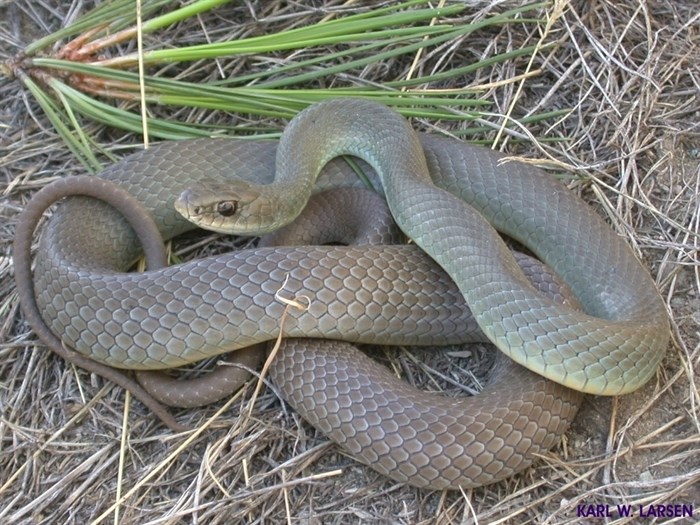
FILE PHOTO - Western yellow-bellied racer snake
Image Credit: Karl Larsen
December 10, 2020 - 6:30 AM
So many snakes were brought to the B.C. Wildlife Park this fall that animal caretakers needed a new fridge and thermometer in order to ensure that the slithery serpents are kept cool in hibernation until the spring.
In mid-October, the Trans Mountain Pipeline group brought 92 snakes to the wildlife park after they were discovered in the path of the pipeline expansion, said Tracy Reynolds, animal care manager at the park.
The larger fridge and thermostat should hold the temperature to 6-7 C for the great basin gopher snakes and western yellow-bellied racers.
READ MORE: Don't be ssscared: The 7 snakes of the Thompson-Okanagan
In a normal year, the wildlife park gets roughly one to five snakes, as construction companies and road workers will occasionally dig them up.
“I don’t think any of us were expecting to find that many snakes in October… I expect them to find a few more in the winter,” Reynolds said.
Ideal hibernating habitat for snakes are few and far between, so that’s why you’ll find quite a large number of snakes in one area. Snakes will also return to their favourite hibernating spot every year, she said. The habitat typically consists of deep fissures in rocks or deep holes.
Reynolds said 60 yellow-bellied racers and 32 great basin gopher snakes were brought to the park. Rattlesnakes were also found, but they were moved to another hibernaculum (hibernating habitat), she said.
Once it’s warm enough, the snakes will be released back into the wild.
“I’m hoping that (habitat) will be rebuilt by then so we’ll be releasing them right back where they came from,” Reynolds said.
Karl Larson, wildlife researcher at TRU who has been studying snakes for years in the Thompson Okanagan region, said he hasn’t been contacted by Trans Mountain, but has questions about the rebuilding of the habitat.
“We know in some cases, yes you can build an artificial den and snakes will colonize that, that’s mainly been (studied with) garter snakes, but we don’t have good information on what proportion (of snakes will use the den),” he said.
“If the snakes were dug up, can you rebuild the den or build one next door and force them to use it or not? And there’s so many unknowns. If you release the snakes in the spring, will they come back and use it?” he said.
An Alberta study revealed that only one-third of roughly 12,000 garter snakes that were moved to a new naturally-existing den returned to it the following winter for hibernation, Larson said.
“Here’s the really big question, what happens to the snakes that don’t come back?” he said. “We need to overlay more detailed research on this to get at how successful these type of ventures are?”
Larson said he hopes to connect with Trans Mountain and said this is a way to gain knowledge on the snakes in order to make the best of a bad situation.
In total, 127 snakes have been captured and relocated in the Lac Du Bois Grasslands vicinity, according to Trans Mountain in an emailed statement.
“Prior to the onset of overwintering behavior, Trans Mountain relocated 35 snakes back into an adjacent natural environment with similar habitat characteristics in accordance with our Trans Mountain Expansion Project commitments.”
With the onset of winter, Trans Mountain relocated the remaining 92 snakes to the wildlife park as per a the request from the Ministry of Forests, Lands, Natural Resource Operations, and Rural Development, according to the email. A qualified environmental professional relocated the snakes to the park because it is too cold to release them to an adjacent habitat location at this time of year, according to the email.
The snake habitat disturbed during construction activities will be reconstructed during the reclamation phase of the expansion project and the snakes will be released in the spring, according to the email.
Materials from the overwintering den has been salvaged and retained for the habitat restoration and additional material may be sourced from surrounding habitats to rebuild the dens.
"We are working with appropriate government authorities on habitat reconstruction and snake release plans. These plans will outline reconstruction requirements for the disturbed overwintering dens and qualified environmental professionals will then monitor the release of the snakes and the recolonization of the overwintering dens," according to Trans Mountain.
As the species are designated under Schedule 1 of the Species at Risk Act, specific locations of the reconstructed dens is considered sensitive information so the exact location of the dens can't be released, according to Trans Mountain.
Trans Mountain has also given a donation to the B.C. Wildlife Park to support their efforts for wildlife care.
To contact a reporter for this story, email Carli Berry or call 250-864-7494 or email the editor. You can also submit photos, videos or news tips to the newsroom and be entered to win a monthly prize draw.
We welcome your comments and opinions on our stories but play nice. We won't censor or delete comments unless they contain off-topic statements or links, unnecessary vulgarity, false facts, spam or obviously fake profiles. If you have any concerns about what you see in comments, email the editor in the link above.
News from © iNFOnews, 2020